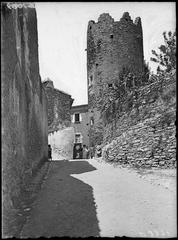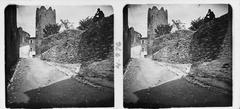
Torre del Mas d’en Pinc: Complete Visiting Guide, Tickets, and Historical Insights
Date: 14/06/2025
Introduction
The Torre del Mas d’en Pinc is a striking example of Catalonia’s coastal defensive architecture and a key symbol of Begur’s multifaceted history. Built in the late 16th century to counter pirate threats, this tower now serves as a cultural and environmental hub, blending medieval heritage, local traditions, and educational opportunities. Situated along the scenic Costa Brava, its preservation allows visitors to experience both its original defensive purpose and its evolving role in community life (Wikipedia - Torres de Begur; MonumentalNet).
This guide provides a detailed overview of the Torre del Mas d’en Pinc—its origins, architecture, cultural legacy, and practical visitor information—making it an essential resource for travelers, history enthusiasts, and anyone interested in Catalonia’s coastal heritage.
Table of Contents
- Historical Overview & Construction
- Architectural Features and Defensive Role
- Integration with Rural Life and the Masia
- Preservation, Restoration, and Contemporary Use
- Cultural & Environmental Significance
- Visitor Information: Location, Hours, Tickets, Accessibility
- Facilities & Surrounding Attractions
- Walking Routes and Scenic Viewpoints
- FAQs
- References
Historical Overview & Construction
Origins Amidst Maritime Threats
The Torre del Mas d’en Pinc is one of five remaining defense towers in Begur, Catalonia, and was constructed in response to increased pirate activity following the fall of Constantinople in 1453. In 1577, royal decrees authorized the construction of private fortified towers. The Torre del Mas d’en Pinc was built during the last third of the 16th century, likely finished in the early 17th century (Wikipedia - Torres de Begur).
Defensive Network
The tower was part of a coordinated network of defensive structures enabling early warnings and mutual protection. When pirates approached, alarms would be raised, and locals sought refuge in these towers, which were strong enough to resist brief sieges (Wikipedia - Torres de Begur).
Architectural Features and Defensive Role
Structure and Materials
The Torre del Mas d’en Pinc stands out with its robust, circular design—measuring about 5.4 meters in diameter and 14.4 meters high—constructed from rough-hewn stone and mortar. Key features include:
- Merlons and Machicolations: Stepped battlements for defender cover; a machicolation (now partially preserved) for dropping objects on attackers.
- Arrow Slits: Narrow openings for surveillance and defense.
- Vaulted Interiors: Two main floors with semi-spherical vaults, originally accessed via ladders for added security (Wikipedia - Torres de Begur).
Integration with the Masia
Unlike most urban towers, Torre del Mas d’en Pinc remains in a rural setting, attached to a traditional Catalan masia (farmhouse). This integration reflects the dual function of defense and daily rural life (Wikipedia - Torres de Begur).
Preservation, Restoration, and Contemporary Use
Decline and Protection
With the decline of piracy in the 18th century, the tower’s military role faded. Its rural location and connection to the masia helped preserve it. In 1944, Begur’s towers were declared historical-artistic monuments, and later recognized as Cultural Assets of National Interest by Catalonia (Wikipedia - Torres de Begur).
Recent Restoration
A major restoration was completed in 2023, funded by the Begur Town Council and Diputació de Girona. Improvements included a new interior staircase, a museum space, and upgrades to lighting and sound systems (Diari de Girona).
Current Role
Today, the tower hosts a permanent exhibition, “Via fora! El perill del mar,” focusing on piracy and Begur’s defensive towers. It is municipally owned and open to the public, offering both educational content and panoramic views (Diari de Girona).
Cultural & Environmental Significance
Maritime Heritage
The tower is a key stop on Begur’s “Ruta de Miradors,” linking historic landmarks and scenic viewpoints. Its location and preservation make it a symbol of the town’s coastal resilience (Visit Begur).
Artistic Legacy: Carmen Amaya
The masia and tower were home to flamenco legend Carmen Amaya in the early 1960s. Her legacy is remembered in local culture, and the approach road is named Passeig de Carmen Amaya (Visit Begur).
Environmental Hub
Since 2016, the site has also served as Begur’s environmental management center and houses organizations like the Nereo Association, instrumental in creating the Ses Negres Marine Reserve (begur.cat).
Visitor Information: Location, Hours, Tickets, Accessibility
Location & Getting There
- Address: Passeig Carmen Amaya, 12, 17255 Begur
- By Car: Onsite parking for cars and small buses (Costa Brava Blog)
- Public Transport: Regional buses from Girona/Barcelona to Begur; 20-minute walk or taxi from Begur bus station
Visiting Hours & Admission
- As of June 2025: Monday–Friday, 9:00–14:00 (Visit Begur)
- Admission: Free; some events or special exhibitions may have a fee
Accessibility
- Main building and gardens: Largely accessible, with ramps and maintained paths
- Historic tower: Limited access due to narrow stairs and doorways (Costa Brava Blog)
- Guided tours: Can be arranged for groups, schools, and organizations
Facilities & Surrounding Attractions
Onsite Amenities
- Parking: Spacious lot adjacent to site
- Restrooms: Available during opening hours
- Visitor Center: Brochures, maps, and multilingual staff
- Exhibition Spaces: Focus on Begur’s history, ecology, and the Ses Negres Marine Reserve
- Library/Archive: For research by appointment
- Multipurpose Room: Seats up to 25, reservable for events
- Gardens: Native plants, shaded seating, and panoramic spots
Nearby Attractions
- Other defensive towers: Can Marquès, Ca n’Armanac, Can Pella i Forgas (elchismografoviajero.blogspot.com)
- Begur Castle ruins
- Indianos mansions
- Ses Negres Marine Reserve
- Costa Brava beaches: Sa Riera, Aiguafreda, Aiguablava
Walking Routes and Scenic Viewpoints
- Forest trail to Cala de Aiguafreda: 45 minutes, moderate difficulty
- Mirador de la Creu viewpoint: Panoramic vistas of the coast and mountains
- Ruta de Miradors: Network of scenic lookouts, ideal for walkers and photographers (Visit Begur; Decouvrir Ensemble)
Frequently Asked Questions (FAQs)
Q: What are the current visiting hours?
A: Monday to Friday, 9:00–14:00 as of June 2025
Q: Is admission free?
A: Yes; special events or exhibitions may require booking or a nominal fee
Q: Is the site accessible for those with reduced mobility?
A: The main building and gardens are accessible; tower access is limited
Q: Are guided tours available?
A: Yes, by prior arrangement for groups and schools
Q: Where can I park?
A: A large parking lot is available onsite
Q: Can I bring my dog?
A: Dogs are permitted outdoors (on leash); not inside buildings or the tower
Visitor Tips
- Visit early morning or late afternoon for best light and cooler weather
- Wear comfortable shoes and bring water and sun protection
- Respect the natural environment and heritage structures
- Supervise children near the tower and on trails
- Contact the Environmental Area for group visits or special needs: +34 872 214 977 / [email protected]
Contact & Further Information
- Visit Begur Official Website
- Begur Tourism Office: +34 972 624 520 / [email protected]
- Environmental Area: +34 872 214 977 / [email protected]
Summary
The Torre del Mas d’en Pinc is a testament to Begur’s rich heritage—blending medieval defense, rural tradition, artistic legacy, and environmental stewardship. Its well-preserved architecture, educational exhibitions, and scenic setting make it one of Costa Brava’s must-see destinations. Combine your visit with other local sites and walking routes for a full experience of Begur’s cultural and natural landscape.
Plan your visit, check official resources for updates, and enhance your experience with interactive guides and maps. The Torre del Mas d’en Pinc promises an enriching journey through Catalonia’s coastal past and present.
References and Further Reading
- Wikipedia - Torres de Begur
- MonumentalNet
- Visit Begur - Torres de Defensa
- Diari de Girona
- Costa Brava Blog
- Catalunya Medieval
- Trip101
- begur.cat
- El Chismografo Viajero Blog
- Visit Begur - Mirador Torre del Mas d’en Pinc
- CSIC Digital Repository
- Spain.info
- Catalan Tourism
- Decouvrir Ensemble


